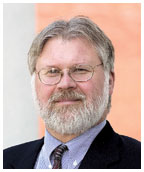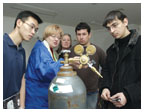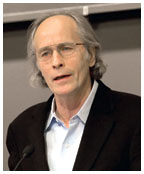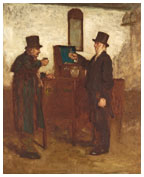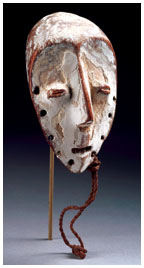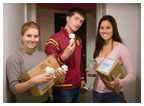
|
May 9, 2007: Notebook
Admission-preference study raises legacy questions
Arts neighborhood plans draw mixed reaction
Princeton admits 1,791 to a ‘most selective’ class
Engineering students test skills in the community
Service honors Va. Tech victims
For Reunions 2007, an artistic flair
Students seek a ‘greener’ campus
Douglas S. Massey *78 (Jon Roemer/Courtesy Woodrow Wilson School) |
Admission-preference study raises legacy questions
A study by Princeton researchers of students whose SAT scores indicate that they received favored treatment for admission to select colleges has found that children of alumni are more likely to stumble academically than minority students or athletes.
For legacy students whose SAT scores were below their college’s average, the wider the gap, the worse were the grades in the freshman and sophomore years, according to research by Douglas S. Massey *78, the Henry G. Bryant Professor of Sociology and Public Affairs, and Margarita Mooney *05, a research fellow with the Office of Population Research.
“We also found that in schools with a stronger commitment to legacy admissions, the children of alumni were more likely to drop out [than non-legacies],” Massey and Mooney wrote in a paper in the February issue of the journal Social Problems.
The study is based on the experiences of about 4,000 students who enrolled in one of 28 selective public and private schools, including Princeton, in 1999.
Discussion of “affirmative action” in college admissions often focuses on preference for minority students, especially among critics of such practices, Massey said in an interview with PAW. But at least as many athletes and alumni children benefit from targeted admission programs, he said. He and Mooney wrote that they hoped their findings would “place the issue of minority affirmative action in a broader context.”
Children of alumni were least likely to receive affirmative action in admissions, the study found, and they earned the highest average GPA of the three groups during their first two years of college. Forty-eight percent of legacy students had SAT scores below the average for their school, compared to 70 percent of athletes and 77 percent of Hispanic and black students. Of students with SAT scores below their institutional average, legacies showed the smallest gap in SAT performance — 47 points below their college average, compared to a 108-point gap for athletes and minorities.
Athletes had the highest retention rates: The study found that 5 percent of all athletes, 7 percent of legacies, and 11 percent of minority students had left school by the middle of their junior year.
The study found evidence of a minority achievement gap, with the authors saying that factors such as socioeconomic status and academic preparation have a much larger effect on college academic success — as measured by grades and retention rates — than affirmative action does.
But affirmative action alone is not causing poorer academic performance for minority students, the authors said. For legacies, on the other hand, benefiting from admissions preference lowers performance.
Massey said Princeton officials have followed his research closely, and University spokeswoman Cass Cliatt ’96 confirmed that the latest findings had been reviewed. “Our data continue to show that alumni children do very well,” Cliatt said.
Dean of Admission Janet Rapelye told PAW in October that Princeton admits
alumni children “at three times the rate of everyone else”
and said that they are “as strong as the rest of the class.”
![]()
By W.R.O.

Frank Wojciechowski |
Demonstrating that their Ford Escape hybrid doesn’t need hands
(or feet) to drive it are Will Hu ’09 in the driver’s seat,
Andrew Saxe ’08 behind him, and Jon Mayer ’09 in the front
passenger seat. The vehicle is the entry of Princeton Autonomous Vehicle
Engineering, a team of more than 30 undergraduates, in a Pentagon-sponsored
competition to develop self-guided vehicles that could deliver supplies
without putting soldiers in harm’s way. A video prepared for the
competition showed the vehicle navigating a 360-meter course set up on
the Forrestal campus, maneuvering turns and driving around a parked car.
Finalists will be invited to complete a 60-mile urban course in less than
six hours Nov. 3; the grand prize is $2 million. To view the video on
the Web, go to pave.princeton.edu/main/media/.![]()

Arts neighborhood plans draw mixed reaction
A NEW HOME FOR THE ARTS
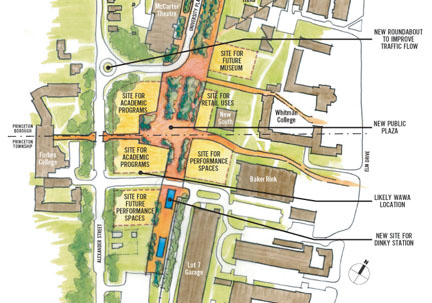
DIAGRAM: Beyer Blinder Belle Architects & Planners
The release of more details about the University’s proposed arts neighborhood south of McCarter Theatre has drawn a mixed reaction from area residents and local officials, who voiced concerns about moving the Dinky station and the project’s effect on the tax rolls.
As Princeton borough and township officials prepared to update the regional master plan, University representatives met with planning officials last month to discuss the ongoing campus planning efforts.
The arts neighborhood proposal has drawn special interest because it combines an expansion of University facilities, some limited retail space, a fresh look at the congested Alexander Road/University Place intersection, and an attempt to coordinate bus and rail service to Princeton Junction. What has been a “back door” to the town and campus could be transformed into a gateway, University planners said.
Robert Durkee ’69, vice president of the University, said moving the Dinky station 460 feet to the south is necessary to coordinate with proposed bus rapid-transit service and to allow direct access from Alexander Street to a University parking garage, which would be open to arts patrons at night. Jitney and shuttle service planned to connect to the new Dinky location should help alleviate concerns of commuters, he said.
Responding to concern that the University would be removing properties from the tax rolls, Durkee said the project includes retail and parking space that would be taxable. The University is the largest taxpayer in both the borough and the township, he noted.
The first phase of work would involve road improvements, including a new roundabout — a small traffic circle — to replace the traffic light at Alexander Street and University Place, Durkee said. A public plaza is planned for the area between the New South office building and Forbes College. Also part of the initial phase would be construction for academic programs, including faculty offices and small rehearsal and performance spaces.
The timing of other parts of the plan, including construction of an
Art Museum annex on University Place and a concert hall on Alexander Street,
would depend in part on fund-raising, Durkee said. ![]()
By W.R.O.

Princeton admits 1,791 to a ‘most selective’ class
Princeton has offered admission to 1,791 students, or 9.5 percent of the record 18,942 students who applied to join the Class of 2011.
“The size, depth, and strength of this record applicant pool meant that we had to make some difficult decisions,” said Dean of Admission Janet Rapelye. She noted that the University had to be “the most selective [it] has been in recent history.”
Of the admitted students, 53 percent are men and 47 percent are women. International students make up 10.6 percent. About 44 percent of the admitted U.S. students are minority students. (The University would not release a specific racial breakdown.) About half of the admitted students are being offered financial aid.
The University declined to release figures on legacy acceptances, but Rapelye told The Daily Princetonian that they were similar to last year. Alumni children made up 9.9 percent of those admitted to the Class of 2010.
This year, alumni volunteers had personal contact with an unprecedented 95 percent of applicants. The applicant body was strikingly accomplished: Almost one-third had a 4.0 cumulative grade-point average, and more than half had a combined score of at least 2100 (out of a possible 2400) on the three sections of the SAT.
Acceptance letters were mailed March 29 to 1,194 students who had applied through the regular-decision process. Another 597 students were admitted as part of Princeton’s final year of early decision.
About 1,245 students are expected to enroll, 25 more than this year.
For the first time, applicants were able to learn of their admission
status and aid awards online. More than 13,000 students checked their
decisions in the first 12 hours, Rapelye said. ![]()

Engineering students test skills in the community
EPICS students used carbon dioxide as a tracer when measuring the ventilation rate of the Stony Brook-Millstone Watershed Association's education center. Setting up the experiment are, from left, Eric Hui ’09, associate professor Catherine Peters, property manager Bay Weber, Greg Hiller ’08, and Dobromir Parushev ’10. (Frank Wojciechowski) |
Making houses energy-efficient and environmentally friendly requires striking an important balance: A green home should have good ventilation, to ensure healthy indoor air quality, but it also needs to be well-sealed to prevent wasting energy. It’s a great problem for engineering students to explore, according to Catherine Peters, an associate professor of civil and environmental engineering.
Under Peters’ guidance, 12 undergraduates are testing their ideas through Engineering Projects in Community Service (EPICS), a yearlong course recently added to Princeton’s engineering curriculum. The students are working with a local nonprofit partner, the Stony Brook-Millstone Watershed Association, to retrofit a ranch house used as the group’s education and outreach center.
“Ultimately, the goal is to demonstrate some of the types of things that homeowners can do to retrofit houses for energy efficiency,” Peters said. The EPICS course, which is equivalent to a half-credit independent study project, takes on partnerships that are designed to span several years, and students are encouraged to re-enroll.
Ed Coyle *82, this year’s Kenan Visiting Professor for Distinguished Teaching, launched Princeton’s EPICS course last fall. Coyle founded the program at Purdue more than a decade ago with colleague Leah Jamieson *77, and EPICS has since spread to 17 U.S. colleges. Coyle’s initial goal was to teach engineers skills that go beyond technical knowledge, such as communicating with teammates and managing projects. By working with community partners, he saw a potential win-win scenario: Community groups get valuable technical assistance; students get to work with real clients.
At many schools, Coyle said, the greatest obstacle to launching an EPICS program is finding potential partners, but at Princeton, the Community-Based Learning Initiative staff provided a long list of options. Coyle and his colleagues considered five projects before choosing two: the retrofitting project of Peters’ team; and the restoration of a century-old clock tower at a former factory in Hamilton, N.J., now owned by the Trenton-based nonprofit group Isles. Mechanical and aerospace engineering professor Michael Littman, an expert on historical mechanical devices, is the adviser for the clock-tower work.
The EPICS program is designed to draw students from several majors. Peters’ group, for instance, includes concentrators from civil and environmental engineering, operations research and financial engineering, geosciences, physics, and the Woodrow Wilson School. The students work in subgroups and take on individual tasks, meeting weekly to review their progress. It has the feel of a small consulting firm, Peters said, and each student’s grade relies in part on the collective success of the team.
Team leader Brian Elbogen ’07 worked for a management-consulting firm last summer, an experience he said has parallels to EPICS. “You learn a new skill set that you don’t get in normal classroom environments,” he said.
So far, the students on the green-retrofitting team have conducted an extensive energy audit, studying the building’s ventilation rate and using a thermal infrared camera to see where it loses heat. This month, they plan to present their findings and recommendations to their community partners.
For the clock-restoration team, fieldwork has been more difficult. Water damage in the clock tower has delayed the removal of the actual clock, so the group’s five students spent much of the spring semester researching clock mechanics and building models. They shared some of what they’ve learned with local third-, fourth-, and fifth-graders in an after-school program called Princeton Young Achievers, using models built with plastic K’NEX toys.
Working with the elementary school students was a new kind of community
service for Sara Oon ’10. “I’ve been giving my time,
but now I’m actually giving my expertise,” she said. “It
feels more meaningful and more real.” ![]()
By B.T.

(Hyunseok Shim ’08) |
“Sometimes readers will ask people like me why we become writers. … I tell them that writers, in spite of appearances, are often people who just want to fit in someplace but, for reasons that are too pathetic to go into, can only do that through the agency of events that we dream up.”
Novelist Richard Ford, delivering the Spencer Trask Lecture April 18
in McCosh 50 on “Extra-Literary Influences: The Things That Help,
The Things That Hurt.” ![]()

Service honors Va. Tech victims
The day after a gunman killed 32 people on the campus of Virginia Tech, about 400 members of the Princeton community gathered in Richardson Auditorium to express their solidarity and sorrow.
The April 17 service included prayer, a moment of silence in honor of the victims and their families, and musical performances by students.
“Princeton and Virginia Tech are partners in research, teaching, learning, caring, leading, and serving,” said Provost Christopher Eisgruber ’83. “Most of all, we are partners in the life-affirming project of education.”
Rob Biederman ’08, president of the Undergraduate Student Government, emphasized the solidarity of Princeton students with their peers in Virginia. “While on different campuses, we are experiencing college together,” he said. “The events that shook Virginia Tech’s campus should resonate with us forever.”
Paul Raushenbush, associate dean of religious life, encouraged students
to reach out to one another and stressed the University’s support
systems, including counseling. ![]()
By Bianca Bosker ’08

Study for “A Glass with the Squire” by Eastman Johnson, once known as “the American Rembrandt.” Part of the “’57 Collects” exhibition, it is a gift to the Art Museum by Stuart Feld ’57 and his wife, Sue.
This maskette of the Lega people of central Africa has been promised as a gift to the Art Museum by Perry Smith ’57. |
For Reunions 2007, an artistic flair
(Courtesy PUAM)
While the Reunions weekend of May 31–June 3 offers alumni a variety of opportunities to celebrate their connection with Princeton, the Class of 1957 is marking its 50th reunion in a distinctly artistic way. A special exhibition at the University Art Museum will present works of art in the collections of class members, and a number of works have been promised as donations to the museum.
“There are several world-class collections in the class,” said Karl Kussorow, the museum’s assistant curator of later Western art. “This exhibition will offer a wonderful cross-section of works — the quality is very high.”
The exhibition was conceived by Jim Kraft ’57, who previously had donated a collection of more than 600 prints to the museum.
While the hope is that classmates would consider donating the art to the museum, Kraft said, no commitment was required to participate in the exhibit. He gave credit to classmates Henry Bessire, Stuart Feld, Byron Bell, and the late Richard Fisher for making the exhibition happen, and said he hoped its success would prompt future classes to work with the museum.
Museum Director Susan Taylor said the exhibition is “reconnecting alumni to Princeton in a very special and specific way.”
The exhibition, “’57 Collects: A 50th Anniversary Celebration,” opens May 19 and runs through Aug. 12. Kusserow said it will include about 40 works, from 15 to 20 members of the class, that range in style from African to pre-Columbian to Greek, Old Masters, and a number of American pieces.
About 25 percent of the works have been promised as gifts to the museum, Kusserow said, and the museum hopes that number will increase. “Alumni donations have been the lifeblood of this institution,” he said.
Kusserow said the museum was particularly excited about the donation by Feld and his wife, Sue, of a work painted about 1880 by the American artist Eastman Johnson, a study for “A Glass with the Squire.” Said art and archaeology professor John Wilmerding: “It is not often a single gift could be said to represent a transformative moment for the Art Museum’s holdings, but this is one to welcome with huzzahs.”
The Alumni Association expects about 20,000 alumni, their family, and friends to visit the campus during Reunions. President Tilghman will hold her annual conversation with alumni Saturday at 10:30 a.m. in Richardson Auditorium, with the P-rade stepping off at 2 p.m. The University Orchestra will perform at Finney and Campbell fields at 8 p.m., followed by fireworks at 9:15 p.m.
Alumni-faculty forums will be held Friday and Saturday mornings and Friday afternoon, with topics that include balancing work and personal life, civil liberties in an age of counter-terrorism, the future of the arts at Princeton, and the place of the athlete in the university.
For a complete schedule of Reunions events, visit the Alumni Association’s
Web site at http://www-alumni-edit.princeton.edu/main/goinback/.
![]()
By W.R.O.

Displaying energy-efficient fluorescent lightbulbs to be distributed to the eating clubs are, from left, Kathryn Andersen ’08, former president of Greening Princeton; Recyclemania coordinator Mark Smith ’09; and Kelsey Stallings ’09, co-president of Greening Princeton. (Hyunseok Shim ’08) |
Students seek a ‘greener’ campus
With campus virtually abandoned during fall and winter breaks, a gang of students crept into dozens of deserted dorm rooms. They noted whether windows were open and made a list of all the electronics in the room. Unplugging appliances and shutting off lights, they fled the scene.
A rash of breaking-and-entering incidents? No, these students (accompanied by building-services employees, who unlocked the doors) were working for the “Pull-the-Plug” campaign, keeping tabs on energy usage. Introduced by Students United for a Responsible Global Environment (SURGE) and the conservation group Greening Princeton, this project was the latest weapon in Princeton’s campaign for sustainability.
The “College Sustainability Report Card,” released in January by the Sustainable Endowments Institute, placed Princeton’s eco-friendly use of resources in the top third of the 100 wealthiest universities in the United States and Canada. The report lauded the University for hiring a full-time sustainability manager, Shana Weber, and for creating energy-conscious guidelines for new buildings on campus. It criticized a lack of transparency in investments by the University. What the report didn’t mention, though, are the efforts by students to make the verdant campus even greener.
Sitting outside Frist Campus Center last month, in prime viewing territory for students on the way to class and pre-frosh hopefuls on Orange Key tours, was a massive pile of cardboard boxes and plastic bags, all topped by a giant tent. The display represented the volume of recyclable waste that is thrown out every day, explained Mark Smith ’09, a coordinator of Princeton’s entry into Recyclemania, a contest among 201 U.S. colleges to see which could collect the largest amount of recyclables over a 10-week period.
Princeton finished 22nd overall with a 30.2 percent cumulative recyling rate and fifth in the category of food-service waste. This was the second year Princeton took part in the competition, and Smith said he noticed “considerably greater awareness” this year. “Recycling is a really tangible way for people to make a difference,” he said.
Among the backers of Princeton’s Recyclemania entry is Greening Princeton, one of the University’s most active environmentalist groups. Aside from single-shot projects like the recycling contest, the group focuses on long-term initiatives. Its success, said former group president Kathryn Andersen ’08, “speaks to the cohesiveness of Princeton University as a whole, [in terms of] how approachable people in facilities or building services or dining services are.”
As part of an ongoing effort to improve food sustainability on campus, the group recently succeeded in getting dining services to offer hamburgers from grass-fed cows once a week in all residential dining halls. Greening Princeton also has introduced organic chicken and seafood into the dining halls, and is exploring more vegan options as well as local organic food.
Eventually, some of those environmentally friendly foodstuffs may sprout among the collegiate gothic buildings. Greening Princeton and the Office of Sustainability are working to establish an organic garden at Forbes College. Once the effort is in full swing, said Ruthie Schwab ’09, who is leading the project, the crop schedules will give rise to new student activities during the year, such as make-your-own-pesto nights, harvest dinners, and cooking demonstrations.
In addition to nurturing edible flowers, peas, beets, and the like, the project aims to “cultivate interest in students about the many issues surrounding our food system and sustainable agriculture,” said Schwab. “The garden is meant to provide a fun hands-on way of reaching students who are not necessarily concerned about sustainability.”
While pilot organic gardens grow under lamps in Forbes and in the Lewis Thomas Greenhouse, students working for the “Cool Bulb Initiative,” sponsored by the Princeton Prospect Foundation together with Greening Princeton, set out to install compact fluorescent lightbulbs in the eating clubs. “The PPF agreed to fund $500 of lightbulbs for each club to get started,” said Greening Princeton co-president Kelsey Stallings ’09. Members of the group delivered the bulbs to the clubs April 16 in conjunction with a number of Earth Week events, including an environmental fair in Frist.
Weber, the sustainability manager, said she hopes to better communicate — especially to alumni — “the cutting-edge energy conservation programs existing on campus, and the growing number of truly laudable sustainability programs.”
Some students choose to unite environmentalism with their studies inside the classroom. Last fall, students taking “Toward an Ethical Greenhouse Gas Emissions Trajectory for Princeton University,” the first student-initiated course offered through the environmental studies program, researched ways to reduce CO2 emissions on campus. Among their suggestions: installing more energy-efficient windows and using geothermal heat on campus.
The research is being reviewed by a Woodrow Wilson School task force, taught by associate professor Denise Mauzerall, that is developing policy recommendations for how Princeton can reduce its emissions of carbon dioxide. “President Tilghman has said that she will be receptive to our findings,” Mauzerall said. “We’re delighted.”
Mauzerall is excited about the student activism she has seen. “They’re
passionate about addressing climate change and they’re passionate
about Princeton. They want to see Princeton in a leadership position reducing
greenhouse-gas emissions,” she said. “And they’re very
optimistic.” ![]()
By Laura Fitzpatrick ’08

A $5 MILLION GIFT from Kathryn Wasserman Davis w’30 and her son, University trustee Shelby M.C. Davis ’58, will allow the International Center to expand its programs for students and scholars from abroad. The center, which helps Princeton’s international community learn about the United States and vice versa, will be named in their honor. President Tilghman said that the gift will help the center “strengthen the multicultural character of our University.” Kathryn Wasserman Davis is the widow of Shelby Cullom Davis ’30, the U.S. ambassador to Switzerland from 1969 to 1975.
THREE MATH STUDENTS — Ana Caraiani ’07, Andrei Negut ’08, and Aaron Pixton ’08 — have won the team prize in the William Lowell Putnam Mathematical Competition, beating 507 other university teams from the United States and Canada. It was the first time Princeton took top honors. The competition’s 12 questions were so difficult that only a few of the 3,640 participants could solve them.
The Daily Princetonian is inviting alumni and friends to a “celebration of the life, contributions, and spirit” of LARRY DUPRAZ h’71 h’00 June 3 from 10:30 a.m. to noon in Frick Hall’s Kresge Auditorium. DuPraz, who died Dec. 24, served as the Prince’s production supervisor for decades and as mentor to generations of student journalists.
The International Astronomical Union honored ROBERT HARGRAVES
*59 by naming a crater on Mars after the late professor of
geosciences. Hargraves, who taught at Princeton from 1961 to 1994 and
died in 2003, was the principal investigator for study of the magnetic
properties of Martian rocks and dust on two NASA missions, the Viking
landing mission in 1976 and the Pathfinder mission in 1996. His first
experiment yielded the surprising result that Martian dust is “enormously
magnetic,” said geosciences professor T.C. Onstott *81, one of Hargraves’
former students. ![]()

